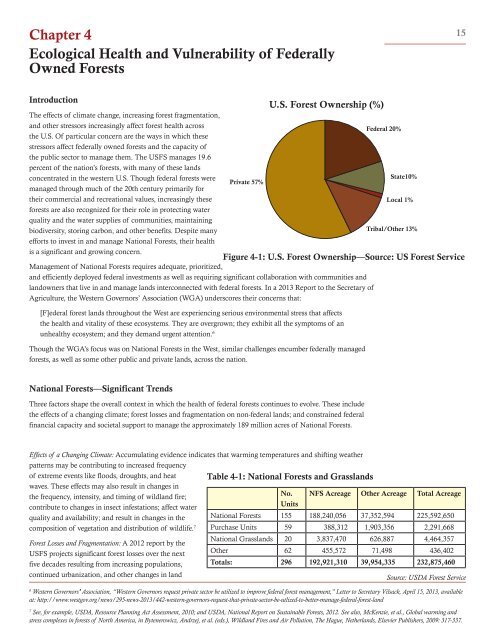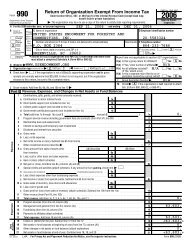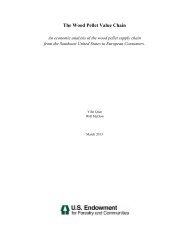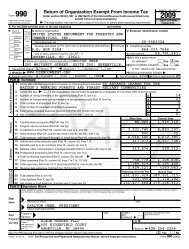The State and Future of U.S. Forestry and the Forest Industry (May ...
The State and Future of U.S. Forestry and the Forest Industry (May ...
The State and Future of U.S. Forestry and the Forest Industry (May ...
Create successful ePaper yourself
Turn your PDF publications into a flip-book with our unique Google optimized e-Paper software.
Chapter 4Ecological Health <strong>and</strong> Vulnerability <strong>of</strong> FederallyOwned <strong>Forest</strong>s15Introduction<strong>The</strong> effects <strong>of</strong> climate change, increasing forest fragmentation,<strong>and</strong> o<strong>the</strong>r stressors increasingly affect forest health across<strong>the</strong> U.S. Of particular concern are <strong>the</strong> ways in which <strong>the</strong>sestressors affect federally owned forests <strong>and</strong> <strong>the</strong> capacity <strong>of</strong><strong>the</strong> public sector to manage <strong>the</strong>m. <strong>The</strong> USFS manages 19.6percent <strong>of</strong> <strong>the</strong> nation’s forests, with many <strong>of</strong> <strong>the</strong>se l<strong>and</strong>sconcentrated in <strong>the</strong> western U.S. Though federal forests weremanaged through much <strong>of</strong> <strong>the</strong> 20th century primarily for<strong>the</strong>ir commercial <strong>and</strong> recreational values, increasingly <strong>the</strong>seforests are also recognized for <strong>the</strong>ir role in protecting waterquality <strong>and</strong> <strong>the</strong> water supplies <strong>of</strong> communities, maintainingbiodiversity, storing carbon, <strong>and</strong> o<strong>the</strong>r benefits. Despite manyefforts to invest in <strong>and</strong> manage National <strong>Forest</strong>s, <strong>the</strong>ir healthis a significant <strong>and</strong> growing concern.Private 57%U.S. <strong>Forest</strong> Ownership (%)Management <strong>of</strong> National <strong>Forest</strong>s requires adequate, prioritized,<strong>and</strong> efficiently deployed federal investments as well as requiring significant collaboration with communities <strong>and</strong>l<strong>and</strong>owners that live in <strong>and</strong> manage l<strong>and</strong>s interconnected with federal forests. In a 2013 Report to <strong>the</strong> Secretary <strong>of</strong>Agriculture, <strong>the</strong> Western Governors’ Association (WGA) underscores <strong>the</strong>ir concerns that:[F]ederal forest l<strong>and</strong>s throughout <strong>the</strong> West are experiencing serious environmental stress that affects<strong>the</strong> health <strong>and</strong> vitality <strong>of</strong> <strong>the</strong>se ecosystems. <strong>The</strong>y are overgrown; <strong>the</strong>y exhibit all <strong>the</strong> symptoms <strong>of</strong> anunhealthy ecosystem; <strong>and</strong> <strong>the</strong>y dem<strong>and</strong> urgent attention. 6Though <strong>the</strong> WGA’s focus was on National <strong>Forest</strong>s in <strong>the</strong> West, similar challenges encumber federally managedforests, as well as some o<strong>the</strong>r public <strong>and</strong> private l<strong>and</strong>s, across <strong>the</strong> nation.Federal 20%<strong>State</strong>10%Local 1%Tribal/O<strong>the</strong>r 13%Figure 4-1: U.S. <strong>Forest</strong> Ownership—Source: US <strong>Forest</strong> ServiceNational <strong>Forest</strong>s—Significant TrendsThree factors shape <strong>the</strong> overall context in which <strong>the</strong> health <strong>of</strong> federal forests continues to evolve. <strong>The</strong>se include<strong>the</strong> effects <strong>of</strong> a changing climate; forest losses <strong>and</strong> fragmentation on non-federal l<strong>and</strong>s; <strong>and</strong> constrained federalfinancial capacity <strong>and</strong> societal support to manage <strong>the</strong> approximately 189 million acres <strong>of</strong> National <strong>Forest</strong>s.Effects <strong>of</strong> a Changing Climate: Accumulating evidence indicates that warming temperatures <strong>and</strong> shifting wea<strong>the</strong>rpatterns may be contributing to increased frequencyTable 4-1: National <strong>Forest</strong>s <strong>and</strong> Grassl<strong>and</strong>s<strong>of</strong> extreme events like floods, droughts, <strong>and</strong> heatwaves. <strong>The</strong>se effects may also result in changes in<strong>the</strong> frequency, intensity, <strong>and</strong> timing <strong>of</strong> wildl<strong>and</strong> fire;contribute to changes in insect infestations; affect waterquality <strong>and</strong> availability; <strong>and</strong> result in changes in <strong>the</strong>composition <strong>of</strong> vegetation <strong>and</strong> distribution <strong>of</strong> wildlife. 7<strong>Forest</strong> Losses <strong>and</strong> Fragmentation: A 2012 report by <strong>the</strong>USFS projects significant forest losses over <strong>the</strong> nextfive decades resulting from increasing populations,continued urbanization, <strong>and</strong> o<strong>the</strong>r changes in l<strong>and</strong>6Western Governors’ Association, “Western Governors request private sector be utilized to improve federal forest management,” Letter to Secretary Vilsack, April 15, 2013, availableat: http://www.westgov.org/news/295-news-2013/442-western-governors-request-that-private-sector-be-utlized-to-better-manage-federal-forest-l<strong>and</strong>7See, for example, USDA, Resource Planning Act Assessment, 2010; <strong>and</strong> USDA, National Report on Sustainable <strong>Forest</strong>s, 2012. See also, McKenzie, et al., Global warming <strong>and</strong>stress complexes in forests <strong>of</strong> North America, in Bytenerowicz, Andrzej, et al. (eds.), Wildl<strong>and</strong> Fires <strong>and</strong> Air Pollution, <strong>The</strong> Hague, Ne<strong>the</strong>rl<strong>and</strong>s, Elsevier Publishers, 2009: 317-337.No.UnitsNFS Acreage O<strong>the</strong>r Acreage Total AcreageNational <strong>Forest</strong>s 155 188,240,056 37,352,594 225,592,650Purchase Units 59 388,312 1,903,356 2,291,668National Grassl<strong>and</strong>s 20 3,837,470 626,887 4,464,357O<strong>the</strong>r 62 455,572 71,498 436,402Totals: 296 192,921,310 39,954,335 232,875,460Source: USDA <strong>Forest</strong> Service





